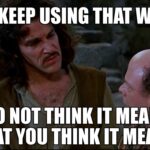Superman, I defy you!
I’m a big fan of David Trottier, AKA “Dr. Format” and his books, “The Screenwriter’s Bible” and “Dr. Format Tells All.” I’m also really impressed by Christopher Riley’s book, “The Hollywood Standard.”
Between the two of these legends of screenplay formatting and style, a writer and consultant like myself has all he needs.
And yet… There’s one aspect of screenwriting where I strongly disagree with both of them:
Text message formatting.
What in the…?
For some reason, these two yahoos esteemed gentlemen seem to think it’s a good idea to format text conversations like dialogue.
In my opinion, that’s an absurd proposition.
Readers’ eyes are accustomed to scanning scripts for scene headings, action lines, dialogue and transitions. If you start mixing the formatting of something that is strictly intended to be shown on screen with the formatting of something that has always been intended to be heard on screen, it’s a bad idea.
Our puny brains can only process so much information. Why confuse things?
- Is the audience supposed to be hearing this text spoken in voice over?
- Is the person who sent or received the text supposed to be reading the text out?
- Are we just supposed to be seeing this text superimposed on screen?
- What happens when you want to do a combination of those things? How will the reader know what we’re supposed to be seeing and hearing?
Sure, there are some stylistic contortions one can use to hammer that square texting peg into a round dialogue hole, but there’s a much easier way.
A new convention
Texting has only been around for a few years and has become a key part of daily life. New ways of communicating require new ways of conveying that communication.
And yet… There are some established precedents that we can use so we don’t have to reinvent the wheel.
Secondary scene headings have long been used to tell the reader we’ve either entered a new sub-location or we’re looking at something localized, like a television broadcast or a computer monitor.
The resulting scene descriptions are always left justified. And that’s how I think text messaging should be formatted.
Example 1
If we’re seeing the text messages superimposed over the action, you would write something like:
INT. PAUL’S APARTMENT – NIGHT
As Paul mops up blood on the floor, his CELL PHONE DINGS.
Text messages are SUPERIMPOSED on screen:
“GORDON: Hey, you comin?”
“GORDON: Where the hell you at???”
“GORDON: Srsly dude. I aint got all night.”
Finally, Paul puts down the mop, checks his cell.
“PAUL: Chill. I’ll be right down. Donnie stopped by.”
“GORDON: Donnie?? That dude’s dead to me.”
“PAUL: Me too.”
Notice, above, how it’s perfectly acceptable to use misspellings and colloquialisms in text conversations. Just don’t overdo it to the point of incomprehension.
Example 2
Alternatively, if we’re just meant to see the cell phone, and the characters are using a messaging app (where the names probably wouldn’t appear on screen), you might write something like:
INT. PAUL’S APARTMENT – NIGHT
As Paul mops up blood on the floor, his CELL PHONE DINGS. He quickly quickly snatches it off the table.
CELL PHONE
GORDON: “Hey, you comin?”
GORDON: “Where the hell you at???”
GORDON: “Srsly dude. I aint got all night.”
PAUL: “Chill. I’ll be right down. Donnie stopped by.”
GORDON: “Donnie?? That dude’s dead to me.”
BACK TO SCENE
Paul smirks as he types out his response, which is SUPERIMPOSED next to him:
“PAUL: Me too.”
In the example above, there’s a combination of the view of a cell phone and a message designed to pop up on screen for the audience to see. Notice how the quotation marks are used differently? When we’re just seeing the cell phone message, the name is provided a guide to the reader. However, when we see it superimposed on screen, it’s surrounded by quotes because both the name of the person typing the message and the message itself will appear on screen.
Example 3
If you wanted to combine texting with a conversation, using my suggested method makes it really easy to distinguish what it is we’re seeing and hearing.
INT. PAUL’S APARTMENT – NIGHT
As Paul mops up blood on the floor, his CELL PHONE DINGS. He quickly quickly snatches it off the table.
CELL PHONE
GORDON: “Hey, you comin?”
GORDON: “Where the hell you at???”
GORDON: “Srsly dude. I aint got all night.”
BACK TO SCENE
PAUL
(to himself)
Illiterate mofo, calm down.
CELL PHONE
PAUL: “Chill. I’ll be right down. Donnie stopped by.”
GORDON: “Donnie?? That dude’s dead to me.”
BACK TO SCENE
Paul smirks as he types out his response, continues the conversation, which is SUPERIMPOSED next to him:
“PAUL: Me too.”
“GORDON: Someone’s with me.”
“PAUL: Who?”
The blood leaves Paul’s face as his PHONE DINGS and he reads Gordon’s response:
PAUL
“Donnie’s sister?”
In the above example, there’s a little of everything, with no confusion as to what we’re seeing or hearing at any given time. Spoken stuff stays in dialogue blocks and stuff that’s only intended to be seen stays flush with the left margin. Imagine if everything were formatted like a dialogue block… It would be comprehension chaos.
How do you format text messages in scripts? Team Trottier or Team Scriptwrecked?






Why not just create a new character status that indicates that what the character is saying is being said via text message?
Hi Iván! Great question. I think it’s just more confusing to do it that way. Anytime I see dialogue block formatting, it makes me think I’m hearing the text, when that may not be the author’s intention at all.
And if it is to be heard in the characters’ voices as well, you’d have to use (TEXT MESSAGE; V.O.) or something, which I guess works but just feels unwieldy to me.